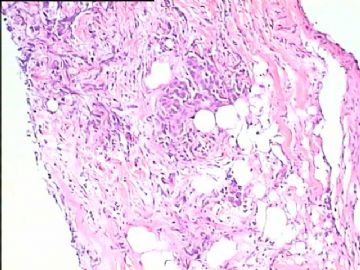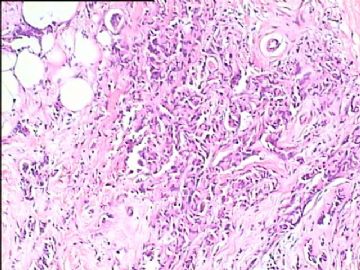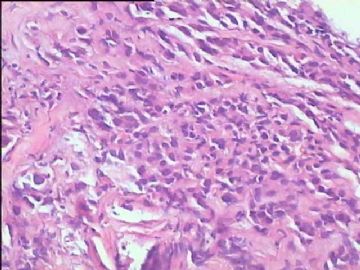| 图片: | |
|---|---|
| 名称: | |
| 描述: | |
- B2861乳腺穿刺
| 姓 名: | ××× | 性别: | 女 | 年龄: | 62 |
| 标本名称: | |||||
| 简要病史: | 现病史不详,6年前有卵巢癌手术史。 | ||||
| 肉眼检查: | |||||

- 嫁人就嫁灰太狼,学习要上华夏网。
相关帖子
Based on the photos, it is not clear for the lesion.
1. Make sure it is cancer. Stain myoepithelial and CK markers. Of cause if you are sure based on H@E, you do not need to.
2. Then think about the origin. what kind of ovarian cancer did the patient have? Are the slides available for review? WT1 (ovarian serous ca positive), PAX8, GCDFP may be help.
-
本帖最后由 于 2010-08-26 12:02:00 编辑
Am J Surg Pathol. 2008 Oct;32(10):1566-71.
Expression of pax8 as a useful marker in distinguishing ovarian carcinomas from mammary carcinomas.
Nonaka D, Chiriboga L, Soslow RA.
Department of Pathology, New York University School of Medicine, New York, NY 10016, USA. daisuke.nonaka@med.nyu.edu
Abstract
The ovary is a common site of involvement for metastasis and the breast is one of the most common sources. Metastatic breast carcinoma can mimic a primary ovarian carcinoma. Pax8 is a crucial transcription factor for organogenesis of the thyroid gland, kidney, and Müllerian system, and it also regulates Wilms tumor suppressor gene (WT1) expression. A total of 124 cases of ovarian carcinomas (84 serous papillary, 18 endometrioid, 12 mucinous, 10 clear cell) and 243 cases of invasive breast carcinomas (178 ductal, 65 lobular) were immunostained with Pax8 and WT1 by tissue microarrays to see the differential expression. Pax8 reaction was found in 108 of 124 ovarian carcinomas (87.1%) generally in diffuse staining, including 81 of 84 serous papillary carcinomas (96.4%), 16 of 18 endometrioid carcinomas (88.9%), 10 of 10 clear cell carcinomas (100%), and 1 of 12 mucinous carcinomas (8.3%), whereas WT1 expression was seen in 78 of 124 ovarian carcinomas (62.9%), including 73 of 84 serous papillary carcinomas (86.9%), and 5 of 18 endometrioid carcinomas (27.8%), with no expression in all 10 clear cell carcinomas and 12 mucinous carcinomas. All the mammary carcinomas were completely negative for Pax8, but WT1 expression was seen in 5 of 243 cases (2.1%). Pax8 is a useful marker in the differential diagnosis of ovarian and breast carcinomas, and it seems to be superior to WT1 for the diagnosis of all types of nonmucinous ovarian carcinomas, notably clear cell and endometrioid types where WT1 expression is generally negative or only focal.





















